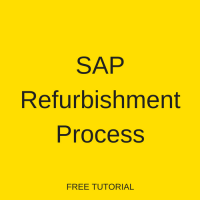 The SAP refurbishment process involves the repair of older or damaged equipment to restore it to workable and efficient condition. In any production plant, refurbishing damaged, high quality and repairable material is a core maintenance process. Refurbishment saves costs over purchasing new components. As part of our free SAP PM training, this tutorial introduces the flow and explains the steps of the refurbishment process.
The SAP refurbishment process involves the repair of older or damaged equipment to restore it to workable and efficient condition. In any production plant, refurbishing damaged, high quality and repairable material is a core maintenance process. Refurbishment saves costs over purchasing new components. As part of our free SAP PM training, this tutorial introduces the flow and explains the steps of the refurbishment process.
The SAP refurbishment process is triggered when an equipment breakdown occurs. A breakdown order to replace the damaged equipment is created. The defective item receives a downgraded valuation type and is replaced and stored in the warehouse. A refurbishment order is created using the material and serial number combination of the damaged material, which is then sent for repair. Once it is repaired, the equipment is returned to the warehouse with an upgraded valuation type. The costs of repair are settled to the material itself.
The system prerequisites for the SAP refurbishment process are as follows:
- Material master record for repairable spares must be created
- Serial numbers for each unit of material must exist
SAP Refurbishment Process Flow
To build upon the high-level description of the process provided above, let’s explore each step in detail throughout the following sections.

Initiate Refurbishment
At this point, an equipment breakdown or defect has occurred. In this step, the replacement spare is procured and exchanged with the defective repairable spare.
Replacement Spare Procurement
When a repairable spare breaks, there may or may not be a replacement spare in the warehouse. If there is not, the procurement team must raise a purchase requisition (PR) from the maintenance plant to procure a replacement spare. The PR follows the company’s normal procure to pay process and the replacement spare is received in the warehouse.
Exchange of Defective and Functional Repairable Spares
Next, the damaged equipment is uninstalled and physically moved to the warehouse. The material master and serial number combination of that specific piece of equipment are used to post a goods movement to storage location, using movement type 101.
Likewise, the replacement spare is installed and a goods issue is completed, using movement type 261. The material master and serial number combination of that specific piece of equipment are used to post the goods issue from the storage location to the production department.
Order
Once the defective repairable spare has been received in the warehouse, the maintenance planner responsible creates a refurbishment order. The timeline, labor, material and tools to complete the refurbishment process are planned and recorded on the order. Once the planning activities are completed, the order is released. This signifies that the work has been initiated.
Material Withdrawal
Next, the responsible technician withdraws the defective repairable spare and other materials required to complete the refurbishment process.
Refurbishment
In this step, the refurbishment process is carried out as planned. The technician responsible for the refurbishment process enters confirmations in the system to capture the actual labor, material and tools required to complete the repair. Upon completion of refurbishment the state of material is changed from damaged to refurbished.
Return
The return of the refurbished repairable spare may be done all at once, or in smaller components if the equipment is very large or complex. The following changes are made to the refurbishment order when the repairable spare is returned to the warehouse:
- Delivered quantity entered on order header
- Order status changed to delivered or partially delivered
- Stock against order updated with the value arising from the quantity delivered and the current price of the refurbished material
Once the return is complete, a goods receipt is posted for the refurbished item. Now the repairable spare is functional and can be used for further material planning or issue to production.
Order Completion
Once all components of the repairable spare have been returned to the warehouse, the refurbishment order can be completed. The status of order is set to TECO – technically completed.
Order Settlement
Finally, the settlement rule is created in the order. Thus, the cost incurred to complete the refurbishment process are settled to the material.
—
Did you like this tutorial? Have any questions or comments? We would love to hear your feedback in the comments section below. It’d be a big help for us, and hopefully it’s something we can address for you in improvement of our free SAP PM tutorials.
Navigation Links
Go to next lesson: SAP Refurbishment Order
Go to previous lesson:
Go to overview of the course: SAP PM Training

Thanks for the detailed documentation. It was really helpful.
Can you please clarify how can I send the specific damaged material back to store for repair if batch management is not active for the same. Is there any way to mention valuation type or any such similar field in PM order to achieve the same?
Thanks in advance.
Sachin,
refurbishment for repaired goods in detail is been explained in next tutorial (SAP Refurbishment Order). Valuation type needs to be map in material master.